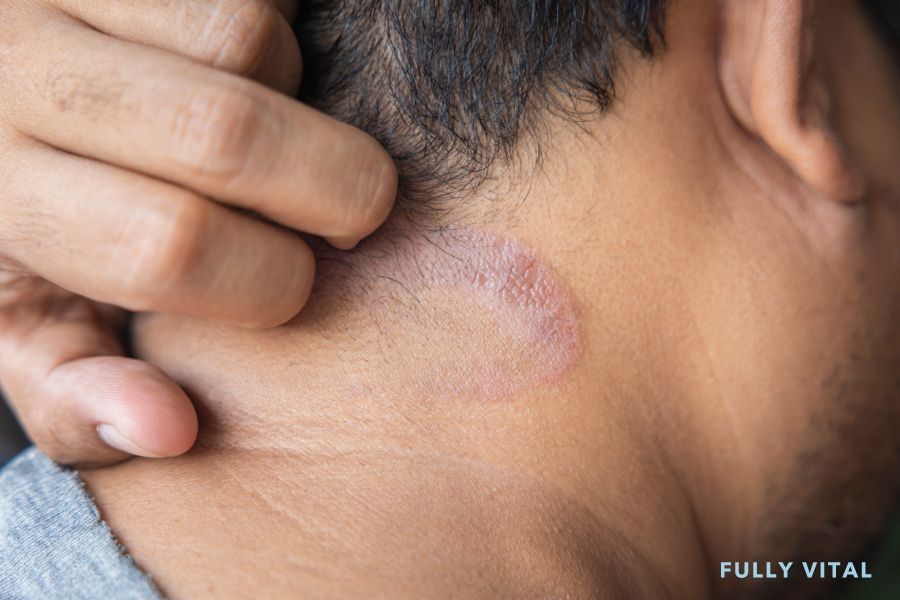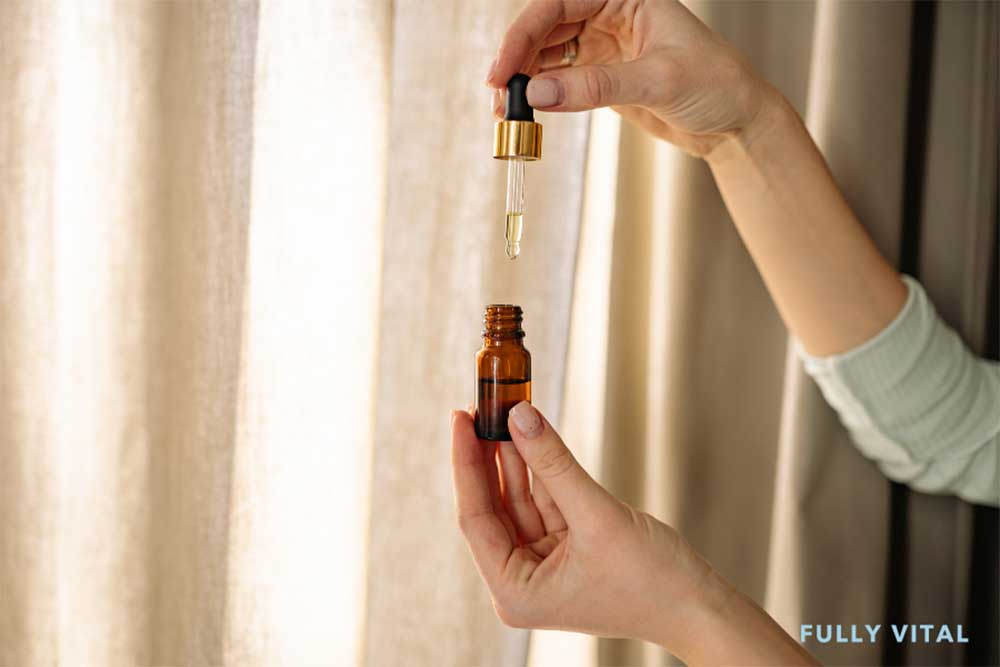
Tinea Capitis: Understanding This Hair Health Concern
Welcome to our dedicated page on tinea capitis – an essential topic for anyone seeking a comprehensive understanding of hair health.
As part of our commitment to providing valuable information, we've crafted this article to address your queries about tinea capitis.
If you're a woman of any hair type striving for improved hair growth, you're in the right place!

I LOVE MY HAIR NOW
FullyVital hair serum and hair vitamins made tremendous improvements in my hair. I truly love my hair now.
Dorit S.,
What Is Tinea Capitis? Unveiling The Basics
Tinea capitis, commonly known as scalp ringworm, is a fungal infection that affects the scalp and hair follicles.
It's caused by various dermatophyte fungi, resulting in symptoms like itching, redness, scaling, and hair loss.
While it's not directly related to hair growth, understanding tinea capitis is crucial for maintaining optimal scalp health.

Why Does Tinea Capitis Deserve Your Attention?
Tinea capitis is important because it can disrupt the health of your scalp and hair follicles.
Left untreated, it may lead to hair thinning and even bald patches.
For women aiming to stimulate hair growth, a healthy scalp forms the foundation.
Addressing tinea capitis is a vital step towards achieving your hair goals.
How Does Tinea Capitis Work? Delving Deeper
Tinea capitis thrives in warm and humid environments, such as sweaty scalps.
The fungi invade hair follicles, triggering inflammation and weakening the hair shafts.(1)
This can result in hair breakage and loss.
Keeping your scalp clean, dry, and using antifungal treatments are key to combating tinea capitis and fostering a suitable environment for hair growth.
What Are The Benefits Of Addressing Tinea Capitis?
Effectively managing tinea capitis offers several benefits for your hair health journey:
Promotes Hair Growth
By eliminating the fungal infection, you create a favorable environment for hair to grow.
Enhances Scalp Health
Tackling tinea capitis reduces itching, redness, and irritation, contributing to a healthier scalp.
Prevents Further Damage
Stopping the infection in its tracks prevents additional hair loss and damage caused by the fungi.
What Are The Potential Drawbacks Of Tinea Capitis Treatment?
While addressing tinea capitis is essential, there are some aspects to consider:
-
Treatment Duration: Resolving tinea capitis may take time and consistent treatment.
-
Possible Side Effects: Antifungal treatments could cause minor skin irritation in some cases.
What Are The Alternatives To Tinea Capitis Treatment?
If you're considering alternatives to tinea capitis treatment, options include:
-
Natural Remedies: Some natural ingredients like tea tree oil have antifungal properties that may help.
-
Medicated Shampoos: Over-the-counter antifungal shampoos can be useful, but consult a dermatologist for guidance.
-
Professional Consultation: If tinea capitis persists, consulting a dermatologist is crucial for proper diagnosis and treatment.
How Does Tinea Capitis Develop On The Scalp?
Tinea capitis develops when certain types of fungi, known as dermatophytes, infect the scalp and hair follicles.
These fungi thrive in warm and humid environments, making the scalp an ideal breeding ground.
It's crucial to understand how this infection spreads to prevent its occurrence.(2)

What Causes Tinea Capitis On The Scalp?
Tinea capitis is caused by dermatophyte fungi, primarily from the Trichophyton and Microsporum species.
These fungi are highly contagious and can spread through direct contact with infected individuals, contaminated objects, or even from animals.
Understanding the sources of infection is essential for prevention.
How Can The Appearance Of Tinea Capitis Be Recognized?
Tinea capitis manifests in various ways, and recognizing its appearance is key to early detection and treatment.
-
Scaly Patches: Affected areas develop scaly patches that may have a reddish border.
-
Hair Breakage: Hair becomes brittle and may break off at or just above the scalp's surface.
-
Patchy Hair Loss: Circular or irregular bald patches are common, often with small black dots representing broken hair shafts.
-
Itching and Discomfort: Itchiness, redness, and discomfort are typical symptoms accompanying tinea capitis.
How Is Tinea Capitis In Hair Typically Treated?
Treating tinea capitis requires a comprehensive approach to eliminate the fungal infection and promote scalp health.
Antifungal Medications
Oral antifungal medications prescribed by a dermatologist are the primary treatment to eradicate the infection from within.
Topical Antifungal Shampoos
Medicated shampoos containing antifungal agents help cleanse the scalp and prevent further spread.
Scalp Care
Maintaining good scalp hygiene, washing hair regularly, and avoiding sharing personal items are crucial during treatment.
Environmental Measures
Disinfecting combs, brushes, and pillowcases can prevent re-infection.
Can Hair Grow Back After Tinea Capitis?
Yes, hair can regrow after tinea capitis, but it requires time, patience, and consistent treatment.
-
Healing the Scalp: Effective treatment clears the infection, allowing the scalp to heal and provide a conducive environment for hair growth.
-
Promoting Regrowth: Hair regrowth may take several months. Proper care, a balanced diet, and maintaining scalp health contribute to healthier hair growth.
-
Addressing Damage: While regrowth occurs, it's important to address any hair breakage or damage caused by the infection.
What Is The History Of Tinea Capitis?
Understanding the historical context of tinea capitis sheds light on its relevance to modern hair care practices.
-
Ancient Accounts: Historical records reveal instances of scalp infections resembling tinea capitis, showcasing its enduring presence.
-
Treatment Evolution: Over the years, treatments have evolved from traditional remedies to modern antifungal medications, reflecting advancements in medical knowledge.
-
Cultural Impact: Tinea capitis has influenced cultural perceptions of scalp health and the importance of maintaining a healthy head of hair.
What Is The Current Landscape Of Tinea Capitis?
Analyzing the current environment surrounding tinea capitis helps gauge its impact on your hair growth product company.
-
Prevalence: Tinea capitis remains a common scalp issue, particularly among children, emphasizing the ongoing need for effective solutions.
-
Consumer Awareness: With increased health awareness, consumers are seeking safe and reliable products to address scalp health issues like tinea capitis.
-
Demand for Holistic Solutions: The current trend towards holistic well-being extends to scalp health. Women are searching for products that align with their overall health goals.
What Is The Future Of Tinea Capitis Care?
Looking ahead, the role of tinea capitis in the realm of hair care is poised for further evolution.
-
Advanced Formulations: Anticipate advancements in antifungal treatments, leading to more targeted and efficient solutions for tinea capitis.
-
Integration with Hair Growth Products: The future may witness the integration of tinea capitis care into comprehensive hair growth product regimens, acknowledging the scalp's vital role.3
-
Empowering Education: Educating your audience about tinea capitis, its prevention, and treatment aligns with your company's mission of providing knowledge-driven solutions.
Revitalize Your Hair With Fully Vital!Discover the power of science-backed hair growth solutions from Fully Vital. Our range of hair products is designed to combat hair aging, empowering you to nurture a healthier connection with your locks. Say goodbye to dull, lifeless hair and embrace the radiance of revitalized strands. Key Features:
Benefits:
Transform your hair care routine with Fully Vital. Embrace the journey to timeless, healthy hair today. |
Final Thoughts On Tinea Capitis
In the journey towards vibrant hair growth, a healthy scalp serves as the foundation for success.
Tinea capitis, while not directly related to hair aging, plays a crucial role in maintaining scalp health.
By understanding the causes, symptoms, and treatments of tinea capitis, you're equipped to address this common concern and pave the way for your locks to flourish.
Remember, a holistic approach to hair care involves nourishing both your strands and your scalp.
At Fully Vital, we're committed to empowering you with the knowledge and solutions you need to cultivate a healthy relationship with your hair.
Our diverse range of hair growth products is designed to halt the aging process, ensuring your locks remain radiant and resilient.
As you embark on this journey to optimal hair health, let the wisdom you've gained about tinea capitis guide your choices.
Your scalp deserves the best care, and your hair will thank you for it.
Frequently Asked Questions About Tinea Capitis
How can I differentiate between tinea capitis and other scalp conditions?
Tinea capitis often presents with distinct scaly patches and hair loss, which might not be as prominent in other scalp conditions.
Can adults get tinea capitis, or is it only common in children?
Tinea capitis can affect individuals of all ages, although it's more prevalent in children.
Is tinea capitis contagious?
Yes, tinea capitis is contagious and can spread through direct contact or sharing contaminated objects.
Can I use regular antifungal creams for tinea capitis?
No, tinea capitis requires specific antifungal treatments formulated for the scalp.
Regular creams might not penetrate the hair follicles effectively.
Are there any preventive measures against tinea capitis?
Maintaining scalp hygiene, avoiding sharing personal items, and wearing breathable fabrics can reduce the risk of tinea capitis.
Will my hair regrow after tinea capitis treatment?
With effective treatment and scalp care, hair regrowth is possible. However, individual results may vary.
Can I continue using hair growth products while treating tinea capitis?
It's recommended to temporarily halt the use of hair growth products during treatment to allow the scalp to heal.
How soon should I seek professional help for tinea capitis?
If you suspect tinea capitis or notice persistent scalp issues, consulting a dermatologist promptly is advisable.
Can tinea capitis return after successful treatment?
Yes, tinea capitis can recur after successful treatment.
Maintaining good scalp hygiene, avoiding contact with infected individuals or objects, and regular check-ups with a dermatologist can help prevent recurrence.
Are there any dietary changes that can help prevent tinea capitis?
Maintaining a balanced diet rich in vitamins and nutrients supports overall health, including scalp health. While it won't directly prevent tinea capitis, a healthy body can better resist infections.
Sources:
-
Al Aboud, A. M., & Crane, J. S. (2020). Tinea Capitis. PubMed; StatPearls Publishing. https://www.ncbi.nlm.nih.gov/books/NBK536909/
-
Hay, R. J. (2016). Tinea Capitis: Current Status. Mycopathologia, 182(1-2), 87–93. https://doi.org/10.1007/s11046-016-0058-8
-
Dhurat, R., Shukla, D., Agrawal, S., Chitalia, J., Ghate, S., & Jage, M. (2021). Tinea Capitis Presenting as Diffuse Hair Loss and Significance of Trichoscopy: Four Case Reports. Skin Appendage Disorders, 7(4), 286–291. https://doi.org/10.1159/000513315







